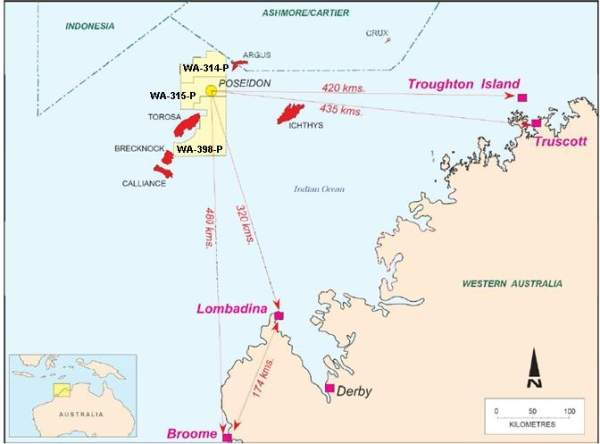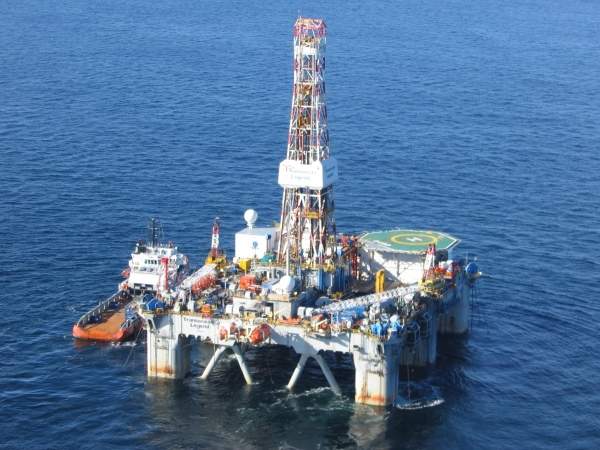Poseidon gas field is situated in the Browse Basin, offshore of Western Australia. It covers permit areas WA-314-P, WA-315-P and WA-398-P which are located 460km north of the Scott Reef that consists of Torosa, Brecknock and Calliance gas fields.
The project is being explored by Australia’s independent gas producer Karoon Gas, along with the joint venture partner ConocoPhillips.
ConocoPhillips is the operator of the field with a working interest of 60% in WA-315-P and WA-398-P, and 10% in WA-314-P. ConocoPhillips sold 50% of the working interest in WA-314-P to Karoon Gas in July 2011.
The sale is currently under scrutiny for regulatory approval. The remaining interest in the blocks is held by Karoon Gas.
Exploration is underway, and the second phase drilling programme will commence in the fourth quarter of 2011. Drilling contracts are being negotiated for the same. If commercially viable, the companies plan to set up an LNG project to meet the growing demand for natural gas in the Asian markets.
Natural reserves
The possible reserves of Poseidon gas field are estimated at 7.6 trillion ft3 of gas and liquids based on the Poseidon-1 drilling data and the pre-drill seismic data set.
Poseidon-1 is the first discovery well in the Poseidon prospect.
Geology of the Browse Basin area
The Browse Basin is a proven hydrocarbon reserve spread over an area of 140,000km2. It was developed over six tectonic phases from late Carboniferous to Late Jurassic to late Miocene inversion. Permian and Triassic thermal subsidence were the intermediate periods.
Oil-prone source rocks are found in lower Cretaceous clay-stones and upper, middle and lower Jurassic sediments and in Triassic and syn-rift Paleozoic sections.
Exploration and drilling programmes
A four well drilling programme was commenced in April 2009 following the endurance 3-D seismic survey of 1,400km2 in 2008. The 3D seismic survey was contracted to CGGVeritas between October 2009 and March 2010. The seismic data was acquired by Fugro-Geoteam.
The Poseidon prospect was spud by semi-submersible rig Transocean Legend Sedco-703. The first discovery well, Poseidon-1 was drilled to a total depth of 317m in the permit area WA-315-P.
It was pulled out in between to conduct a three week test programme in order to determine the gas flow rates and reservoir parameters. The test was however discontinued due to a mechanical failure and Poseidon-1 was plugged out and abandoned.
The well, however, had encountered significant gas resources and demonstrated the presence of high quality gas. The next exploration well was drilled in the same block following this. It was known as Kontiki-1 and had encountered poor quality gas.
Karoon Gas and ConocoPhillips continued the exploration programme due to the encouraging results of Poseidon-1. Two wells, namely Poseidon-2 and Kronos-1, were drilled in permit area WA-398-P.
Poseidon-2, an appraisal well, was drilled to depth of 16,519ft to 16,732ft below Poseidon-1 where the Plover Formation thickens. It was intended to assess the presence and quality of the gas below the discovery well.
Poseidon-2 also encountered significant hydrocarbons. Kronos-1 which was the last well of 2010 exploration is in the high block in the south-west, 15km away from Poseidon-1.
The 3D seismic survey of the greater Poseidon area which covers 2,000km2 necessitates drilling of additional wells to determine the size and potential commercialisation of the project.
Karoon Gas and ConocoPhillips received the environmental approval from the Australian Government in July 2011 to commence the second phase drilling programme in the prospect.
The companies plan to drill four wells in WA-315-P and WA-398-P. This phase is expected to last for between 18 months and two years.
The programme which was supposed to start in early 2011 has been delayed as the government asked to provide more safety data post the Montara oil spill in the northeast coast of Australia in 2009.









